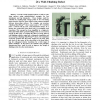Free Online Productivity Tools
i2Speak
i2Symbol
i2OCR
iTex2Img
iWeb2Print
iWeb2Shot
i2Type
iPdf2Split
iPdf2Merge
i2Bopomofo
i2Arabic
i2Style
i2Image
i2PDF
iLatex2Rtf
Sci2ools
ICRA
2008
IEEE
2008
IEEE
A body joint improves vertical to horizontal transitions of a wall-climbing robot
— Several recently-designed robots are able to scale steep surfaces using animal-inspired strategies for foot attachment and leg kinematics. These designs could be valuable for reaching high vantage points or for overcoming large obstacles. However, most of these robots cannot transition between intersecting surfaces. For example, our previous Climbing Mini-Whegs™ robot cannot make a 90° transition from a vertical wall up onto a flat horizontal surface. It is known that cockroaches bend their body to accomplish such transitions. This concept has been simplified to a single-axis body joint which allows ground-walking robots to cross uneven terrain. In this work, we examine the effect of a body joint on wall-climbing vehicles using both a kinematic simulation and two prototype Climbing Mini-Whegs™ robots. The simulation accurately predicts that the better design has the body joint axle closer to the center of the robot than to the front wheellegs for orthogonal exterior transition...
| Added | 30 May 2010 |
| Updated | 30 May 2010 |
| Type | Conference |
| Year | 2008 |
| Where | ICRA |
| Authors | Kathryn A. Daltorio, Timothy C. Witushynsky, Gregory D. Wile, Luther R. Palmer, Anas A. Malek, Mohd Rasyid Ahmad, Lori Southard, Stanislav N. Gorb, Roy E. Ritzmann, Roger D. Quinn |
Comments (0)

